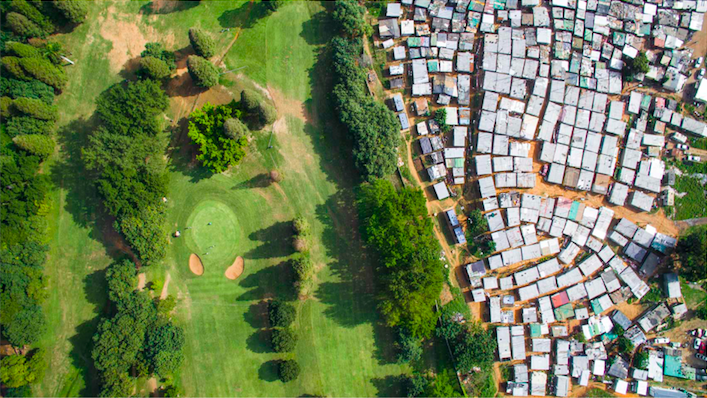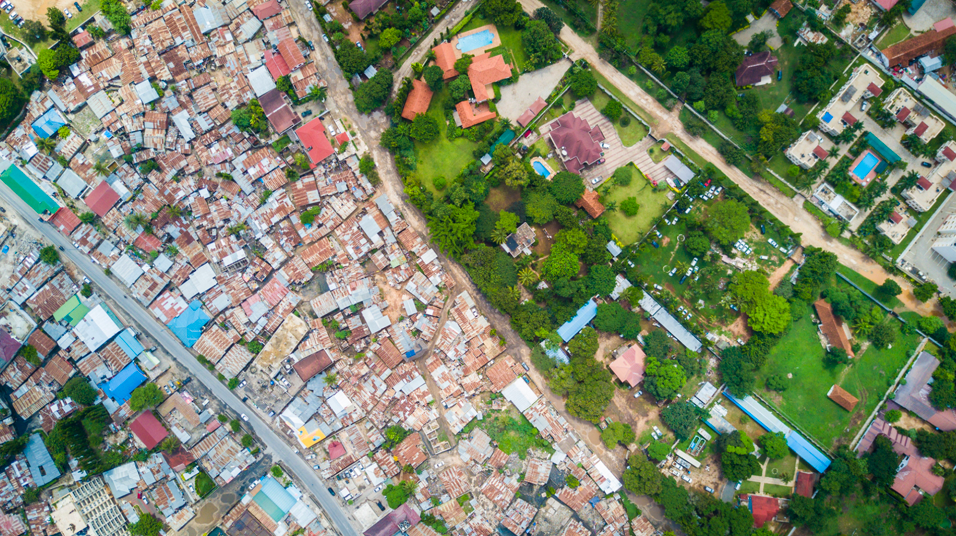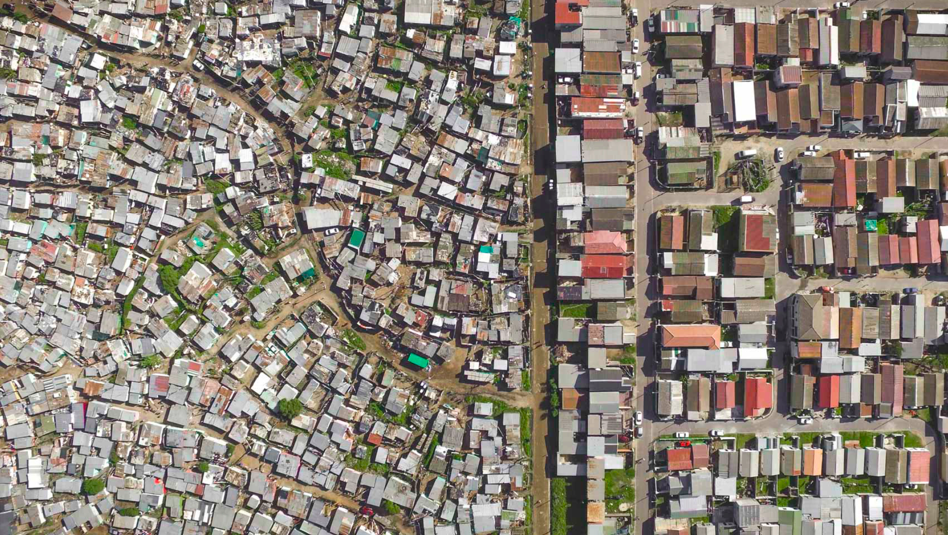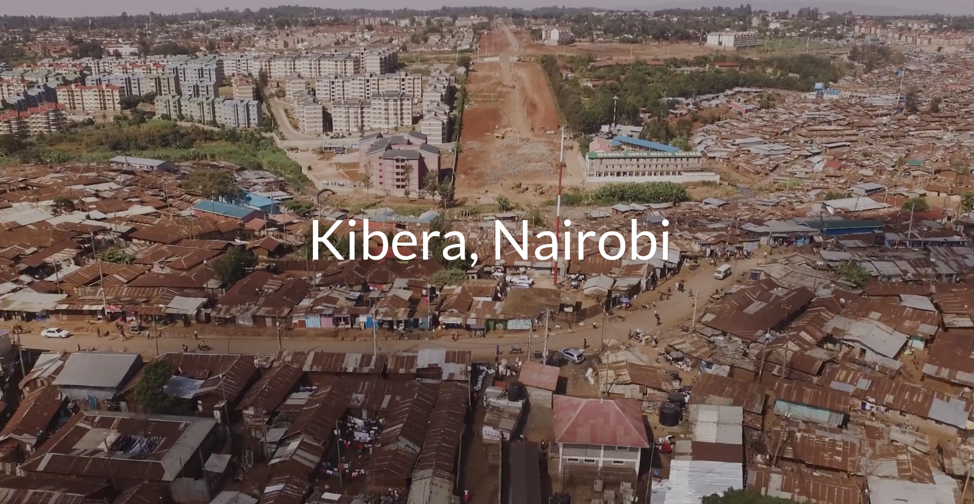Drone photojournalist Johnny Miller is up front about his intentions.
His work, “Unequal Scenes,” is more than a photography project that documents the proximity of people living in poverty and those who live in comfort.
“Make no mistake – ‘Unequal Scenes’ is an act of defiance,” he said. “I defy the traditional power structures that keep these inequalities hidden so well from every direction except directly above. If the images provoke uncomfortable feelings of fear, despair, or an unsettling realization of complicity – good. They are intended to.”

He uses drone photography to document housing inequality. Mostly, he uses still-photo imagery, so the viewer focuses on the undeniable content of the photograph, not the fluid movement of a moving drone video. Most of his photographs look straight down.
Want to hone your drone photography skills? Sign up for Poynter’s newest webinar series, The Flying Camera.
“Looking down, I could see the clear dividing lines,” he said. “That one look captures people’s imagination in ways tilting to the horizon would not do.”
He calls his work “Unequal Scenes” because of the stark separation he documents between the world’s rich and poor neighborhoods, shacks and gentrified subdivisions with swimming pools and lush yards. He says it happens so often around the globe, it can only be “planned intentional disenfranchisement.”

Miller told Poynter that he bought his first drone in 2016.
“I had a photography business in Cape Town, South Africa and I flew the drone up to Table Mountain. I put the video on YouTube and people said they say the mountain in ways they had never seen it before. I saw the drone photography could add value.”
He told the story of that first drone photography experience in a TedX talk, saying “This new perspective, what I called a toy, is actually an extremely powerful piece of technology.”
Miller, who studied anthropology in college, said he wondered what else he could apply this really strong perspective to.
“I was interested in city structures in post-Apartheid South Africa — where was there development and non-development — and I thought it would be interesting to look at that divide from the air.”

Miller said his intent is to spark conversations “on what my photos represent.”
They have done that. The United Nations featured his images on a report about housing inequality. The South African national government uses his images as examples of what it wants to fix. Earlier this year an international development conference in Vienna featured some of his images.
While he does create drone videos that depict the dividing lines between the haves and the have nots, he keeps coming back to the power of the still, the bird’s eye image.
“The power of the drone still photo is that it seems to stick in your brain longer,” he said. “It is easier to create a compelling and profound piece of media that moves because of its ability to hold the viewer’s interest largely because of the apprehension of ‘What’s coming next?’
“I have been really interested in still photography because you have an ability to create a profound moment that lives on far past what you envisioned in the beginning. For video you are less likely to remember what you saw and as the video gets longer it gets even harder to remember the details. My brain sees things in snapshots if I can attach that emotion to that photo, it becomes a really profound connection.”
Miller said everybody can see some of his or her own life in these images. Which side of the dividing line does the viewer live on? Why and what does that mean?
“People see a relevance in it if they are rich or they are poor. Black and white — you can imagine yourself to be in the photo.”
Miller self-funded his work for six months then picked up backing from the Thompson-Reuters Foundation to document similar dividing lines around the world. That underwriting produced “Slumscapes,” which documents the five biggest slums in the world: Nairobi, Africa; Mumbai, India; Cape Town, South Africa; Karachi, Pakistan; and Mexico City.

“Slumscapes” documented how more than 900 million people worldwide — or nearly one in every seven people — live in the world’s slums and now are emerging as a “dominant and distinct type of settlement” in the 21st century. The stories Miller produced explain, “Today one quarter of the world’s city dwellers live in slums — and they are there to stay.”
Miller’s stark images also pointed out that 924 million city dwellers lived in shacks and shanties with no title to their homes or land. The number, Miller reported, “is expected to grow ‘exponentially.’”
Miller says that hovering straight above the dividing lines between refined and dilapidated neighborhoods forces us to see communities we avoid by driving around them or constructing barriers to make them easier to ignore. He says in the opening page of his website for “Unequal Scenes”: “We live within neighborhoods and participate in economies that reinforce inequality. We habituate ourselves with routines and take for granted the built environment of our cities. We’re shocked seeing tin shacks and dilapidated buildings hemmed into neat rows, bounded by the fences, roads, and parks of the wealthiest few. But it’s the very scale and unerring regularity across geographic regions which points to the systemic nature of inequality.”
Miller has become a loud advocate for drones, not just for photography but as what he calls “an equalizing force” and a “democratizing technology.”
“It is a piece of hardware and software that costs a thousand dollars. With drones, anybody can understand the world around them at a level that the governments have been able to do since the advent of things that fly in the sky.”
Miller and his organization African Drone train drone pilots all over the continent how to use drones to create maps.
“Maps are a perfect example of democratization,” Miller said. “With a drone, you don’t have to wait for the government to do it. You can take a photo and map it. You can see what someone is hiding, or they have been lying about. You have the ability to do that and understand it on your own.”
In fact, Miller compares the potential for drones to the internet and mobile phones.
“In Rwanda they are delivering blood and medical supplies with drones. It is important to change the scripts for people to see the world, and drones are fundamentally empowering.”
In fact, he says, drones have so much potential to upset power structures that governments are making it increasingly difficult to legally fly. In South Africa, a licensed drone pilot must go through an onerous five-step process and pay the equivalent of $1,800 to fly legally. But, even then, pilots must fly under the supervision of a drone “operator,” and it costs $7,000 to be a licensed operator. So, Miller said, there are only 20 commercially licensed drone operators in all of South Africa.
Miller said work like his photography and mapping have the potential to make the rich and powerful uncomfortable
“Those people are making it very difficult to fly,” he said. “They are making it a tool of the elite.”
So, Miller said, he built African Drone “as a force for good” offering drone photography, mapping training and teaching journalism skills. The organization’s goals include “giving journalists cheaper and safer access to conflict zones and other hazardous areas, from the epicenter of a natural disaster, to conflict zones, to industry’s toxic no-man lands.”
In exchange for the training, Drone Africa asks that the work that results will be open source and newsrooms that get the training must be willing to share what they learned with others.
In most of journalism, reporters and photojournalists try to put a face on an issue to make the story relatable.
“As a photographer I always thought that if I want to tell someone’s story, the best way to do that is to look into someone’s eyes,” Miller said in his TedX talk. “You take photos and look at people’s faces and try to create empathy by looking into someone’s eyes. But I realized maybe I should start thinking outside the box.”
He added, “We surround ourselves with people who look like us, we surround ourselves with communities that seem like we should be a part of them. We drive the same cars as our friends, we have the same jobs as our friends. Our kids go to the same schools as our friends’ kids.
“It took flying 300 meters above people to completely erase individual humans from the photo to get people to pay attention. Initially I tried to distance myself from being an activist because I wanted to present the images objectively. I think that was a good technique to get people to listen to me.”
He said beyond the lack of electricity, sanitation, there are high rates of crime and disease.
But, he said, “The worst thing I see in these areas I have photographed is the hopelessness.”
In one video he captured over Cape Town’s Monwabisi Park, he explained that every one of the 25,000 people living on the right side of the photo share 10 toilets. On the day Miller was there, eight of the toilets were locked and two were broken.

He broke through not by photographing faces, but by documenting the lines that divide us. This video was the first “Unequal Scenes” drone video he photographed.
He posted the video on his Facebook page and by the time we went to bed he had 300 likes. When he woke up, it had attracted 40,000 views, and hundreds of likes and comments.
“They had all been taken by this perspective,” he said. “I like to say now that the beauty of how things really are become apparent when you fly above them.”






